- Author
- Ross, Trevor Wilson, OBE, Captain, RAN
- Subjects
- Biographies and personal histories
- Tags
-
- RAN Ships
- None noted.
- Publication
- March 1975 edition of the Naval Historical Review (all rights reserved)
For a time I was in charge of Adelaide building at Cockatoo Dockyard before being appointed as Engineer Officer of Brisbane. The Royal Navy had had many troubles and loss of lives with boilers similar to those of Brisbane, two ships of exactly the same class having had explosions. The trouble was due to the ‘wrapper’, or lower plates of the water drums not being cylindrical but flattened somewhat. So that every time steam pressure was raised, the plates flexed.

When we came in for refit, I put in the defect list that all wrapper plates required renewal. Back came the list with ‘ridiculous’ scrawled across it. Nothing daunted and ably assisted by Engineer Lieutenant Ted Mackey, we trepanned cores out of the lines of corrosion in the wrapper plates and found every time ominous cracks. The boilers were condemned. As each boiler was condemned I reported to our Captain, J. B. Stevenson, and finally we put on frock coats and swords and reported to Admiral Dumaresq. The cat was properly among the pigeons! Brisbane was paid off for a long refit. I was most unpopular all round but I had saved the RAN from a terrible and needless boiler explosion.
I was later sent to England and appointed on the staff of the Engineer Manager, Portsmouth Dockyard. Here I had invaluable experience and made many friends, including Naval Constructor Charig who had the task of putting Victory into her permanent berth in an old drydock. All too soon I was sent to RN College, Greenwich, for courses and then appointed Engineer Officer HMS Dragon, then in Malta.
For some curious reason, the van with everyone’s luggage was detached from our train at the Italian border so I reported on board in civilian suit and a bowler hat! This was treated as a great joke but I had a very happy time in the Mediterranean making many more friends. I worked Dragon up to such a pitch of efficiency that she topped all the Fleet in engineering.
Then, in 1928, I was appointed to the County Class cruiser Australia, building at John Brown’s. The story of this ship belongs separately, so I do not propose to tell my part of it here. After five years in her I was a short time in Penguin for ships in reserve and then I was appointed Engineer Officer, Flinders Naval Depot, where I remained for over five years until my fiftieth birthday drew nigh and I was discharged from the RAN. I immediately went to England, and, looking up some of my valuable friends, reported to the Admiralty where the officers concerned said very frankly that the Australian Naval Board must be mad to let me go; I was promptly put on reserve and offered the job of restoring the Colombian Navy to some degree of efficiency. I refused and went touring.
Soon after World War II broke out in 1939 I was called to the Admiralty and placed in the Kite Balloon Section. Our job was to protect coastal merchant ships from attack by enemy aircraft by, first of all, kites and then, when supplies became available, kite balloons. These were flown at 1,000 feet by ultra hard high tensile steel wire. However, no case was recorded of a German aircraft flying into these wires. We experimented from time to time with a bomber fitted with several steel edges to its wings!
The seamen were very keen on this protection and we had a big job keeping up with the demand. In the Admiralty were a Lieutenant Commander in the office, a Commander experimental and trouble shooting, an RNR Commander general liaison with the ports and me, supply and general rouseabout. We were a completely independent body and controlled Lieutenants RNVR in each and every port. These lads had cranky old motor boats and a few hands to transfer equipment back and forth from the ships in convoy.
Our most amusing job was the defence of Fair Isle. This lonely spot was very easily identified and so was used by the German aircraft to fix positions, so we sent a young Lieutenant and a few hands with winches and kites; the gales there were fiendish and on one occasion the kite took off with the winch trailing over the heather. Later, the Royal Marines took over from us and were promptly bombed!
Then Australia requested me, and the Admiralty were not very amused. However, at the beginning of 1942, I was transferred to Australia House as Naval Engineer Officer and remained in the job until October 1950 when C. C. Clark took over.
The variety of work I handled was astounding and my many good friends in the Admiralty were most invaluable to me. I was able to get instantly the latest thoughts and technical data for transmission to Australia. I started right into RDF (radio direction finding) as it was called for years before it became RADAR and all the work of advising Australia as to what sets should be fitted and then obtaining them.
In time, Australia turned to manufacturing aerial torpedoes and all the data and specialist tools had to be obtained – nothing was standard and interchangeable! The construction of warships and merchant ships in Australia required the sending of vast quantities of drawings and specifications, the obtaining and sending of masses of equipment; in all this time, only one shipment was lost by enemy action.
Then came the Captain Cook Dock. It was a very big job – the contracts for various sections, the sending of masses of drawings and most amusing to me – the settling of an argument on pouring of concrete between the designers and the builders – my friends in the Admiralty were very valuable.
The Daring class destroyers were another huge job and entailed, apart from everything else, repeated visits to Sparrows and Samuel White’s, plus John Brown’s, etc. Meantime, I had to process all Australian Naval and Army requirements for engines for power craft and keep a very close liaison with the Army and Supply.
Then came the taking over of the Sydney and Melbourne – one of the biggest jobs was installing the catapult system. Melbourne was no end of a business! The trouble was that our Admiral at the time had dinner with Admiral Bruce Fraser and on the ‘old boy’ basis they agreed we could have the ship at once! This was disaster as it meant that she would be the same as Sydney, same lifts, same aircraft and same obsolescence!
Suitable planes for operating from the ships would be available as they were not being built any longer! My friends in the Admiralty were pushing ahead as fast as possible with the steam catapult – with it, larger, modern planes could be launched; these required larger lifts. Hence we had to keep off the Australian Naval Board until we could announce the success of the steam catapult and recommend its installation together with larger lifts and other details – for that reason Melbourne is still in commission today and Sydney has been written off for disposal.
It was most delightful to have visits from the technical heads of the RAN and the Munitions Department from time to time, as well as the Shipbuilding Board; some of their staffs made their headquarters in my office from time to time, and Gordon Gibbons became a well established friend. I had Assistants at odd times – Jake Menary, Farnsworth and Max Reed spring to memory. I lent Farnsworth to the Admiralty to run a German destroyer acquired after the War – this craft was a mass of kicks and Farnsworth had great fun getting to know it all, take the ships around and explain things to all and sundry.
Max Reed had fun and games with boiler trials amongst other things and we puzzled our heads over ‘Steam Tables’.

I was discharged from the Royal Australian Navy on 30th November 1950, and settled in Hobart where I have, amongst other things, a very large garden to work single-handed. The Naval, Military and Air Force Club, Hobart, holds a dinner every year to commemorate the ‘8th August 1918’ when for the first time the five ANZAC Divisions were brought together under Monash as a separate Army and smashed the German defences to bring about the end of World War I. For many years I have been honoured by being President of this dinner, which I find very touching. My encounter with the Royal Australian Navy was indeed a rewarding time.




